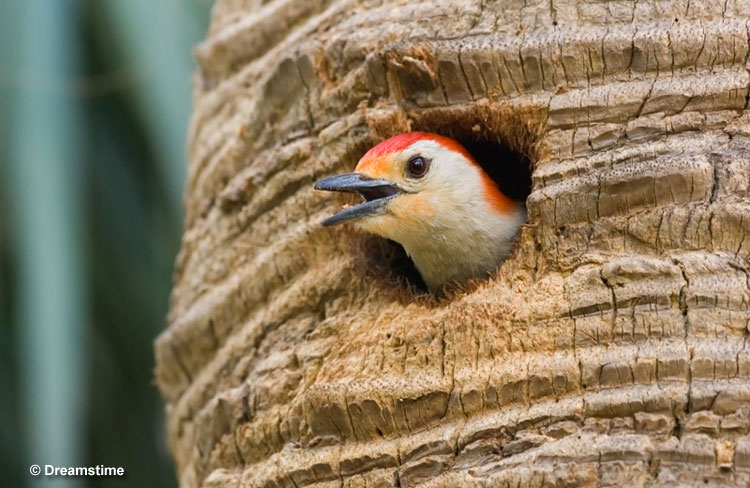
Alabama is a true Woodpecker state – and how could it not? Alabama’s nickname is the Yellowhammer State.
Nor most of us, Yellowhammer is known as the Northern Flicker. But how did they make their way to people’s hearts? And what other woodpecker species make Alabama proud?
Most Common Woodpeckers In Alabama
Based on eBird data, we created a list of famous Alabama woodpeckers and arranged them from most common to least common.
To help with their identification, we also included information about key field marks and their behavior.
Red-bellied Woodpecker
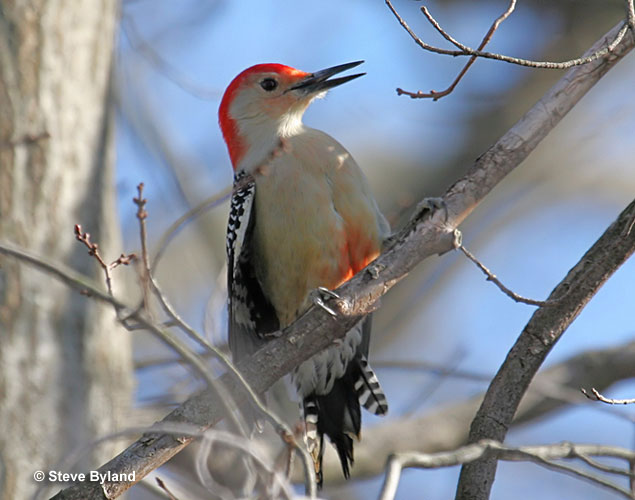
Scientific name: Melanerpes carolinus
Length: 9.25 inches
Wingspan: 16 inches
Red-bellied Woodpeckers are bold birds with a long, dark, chisel-like beak, and backs with zebra-like barring. They also have black and white bars on their long, closed wings, and a bold white rump with some black speckling.
Despite their name, it’s really hard to see the red on this bird’s underparts! Although they do have a bit of red or reddish-orange, it’s hidden on the lower part of their belly. The rest of their underparts and face are a pale gray-buff color, and they have a bit of orange above their beak.
Male Red-bellied Woodpeckers have bright red on their crown and nape. Females only have red on their nape and young birds only show a bit of orange on the back of their head.
We see pairs of this common woodpecker species in all sorts of woodlands. As long as big trees are present, they can even live in urban areas, and often come to feeders.
Key identifications:
- In most of their range, Red-bellied Woodpeckers are the only woodpecker species that has zebra-like, black and white barring on their back and wings.
- Red-bellied Woodpeckers have a pale face and red on their nape.
- This species has plain buff-gray underparts.
Downy Woodpecker

Scientific name: Dryobates pubescens
Length: 6.75 inches
Wingspan: 12 inches
Downy Woodpeckers are small, cute woodpeckers with black and white plumage. They have bold, black and white markings on their heads, black and white wings, and white underparts.
They also have a white back, black rump, and black and white tail. This woodpecker is slightly bigger than a sparrow, and has white, tufted feathers above its short beak.
Male Downy Woodpeckers have a small red patch on the back part of their head. Females look like males but lack this red patch, and young birds have red on the top of their heads.
Downy’s are common in all sorts of wooded habitats.
Key identifications:
- Downy Woodpeckers are smaller than all other woodpeckers in North America. They are nearly as small as a House Sparrow.
- This species has a short and stubby beak (for a woodpecker).
- Downy Woodpeckers have small dark markings on their white outer tail feathers.
Red-headed Woodpecker

Scientific name: Melanerpes erythrocephalus
Length: 9.25 inches
Wingspan: 17 inches
Red-headed Woodpeckers are beautiful, medium-sized woodpeckers with a completely deep red head. Adults of both sexes look alike and have a sharp gray bill, and bright white underparts.
Their upperparts are glossy black with a snow-white rump, and big white patches on their wings. Juvenile Red-headed Woodpeckers have a similar plumage pattern but have a gray-brown head, and some dark markings on their wings and underparts.
This striking bird prefers semi-open habitats with mature oaks, snags, and other big trees. If you’re lucky, you can spot them in urban areas, too!
Red-headed Woodpeckers like to peck into trees like other woodpeckers but they also catch insects in flight. With that in mind, we often see them sallying into the air from tall snags next to open areas.
Key identifications:
- Red-headed Woodpeckers are the only woodpecker species in eastern North America with an entirely red head.
- This species has a unique wing pattern with big white patches on the base of each wing.
- The Red-headed Woodpecker has a black tail and an extensive white rump.
Northern Flicker
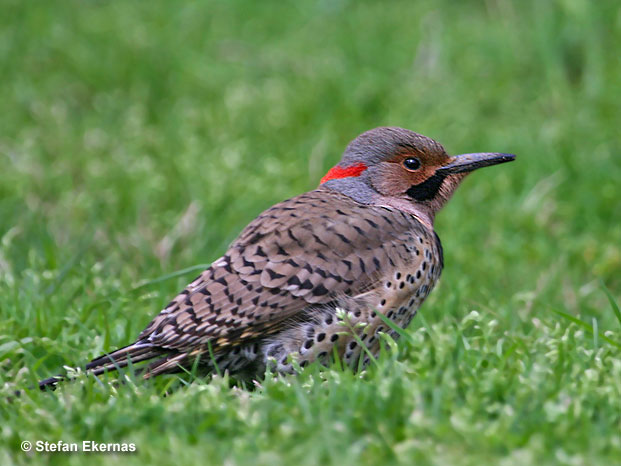
Scientific name: Colaptes auratus
Length: 12.5 inches
Wingspan: 20 inches
Northern Flickers are big, unique, gray and tan woodpeckers with bold white rumps. They have buff underparts with black spotting and a bold black patch on their chest, and fine black barring on their back and wings.
This species has some differences depending on where they live. Birds east of the Rocky Mountains have a small red spot on their nape, and a black moustache mark (males). Eastern birds also have bright yellow underwings, which ultimately gave them the name Yellow-shafted Flicker.
In Alabama, Northern Flickers are highly honored – they carry the title of being the state bird.
Key identifications:
- In most of their range, Northern Flickers are the only woodpecker with gray and brown plumage.
- This species has a gray crown and fine black barring on its tan-colored back.
- Northern Flickers also have a black chest patch and black spotting on their underparts.
Pileated Woodpecker
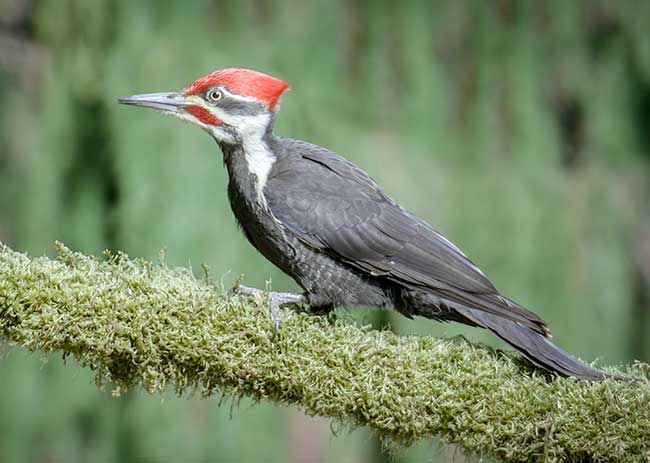
Scientific name: Dryocopus pileatus
Length: 16.5 inches
Wingspan: 29 inches
Pileated Woodpeckers are really big woodpeckers. These hefty birds are nearly the same size as an American Crow!
These unmistakable woodpeckers are mostly black with a thick white line on each side of their neck, and a white throat.
Pileated Woodpeckers have a red crest and a long, grayish beak. Males have a small red moustache, while females have a black line that extends from their beak to their neck.
This fantastic woodpecker lives in forests and woodlands with lots of big, mature trees. For that reason, we don’t usually see them in urban areas.
Key identifications:
- In most places, Pileated Woodpeckers are the only big black and white woodpecker with a red crest.
- This species has a small white patch near the tip of each upperwing. They also have white wing linings.
- Pileated Woodpeckers have a lot of white on their face and a completely black back.
Hairy Woodpecker
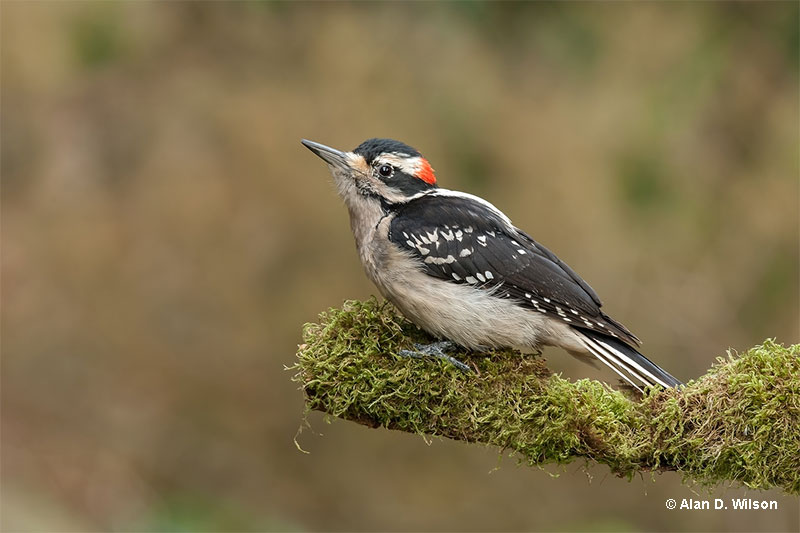
Scientific name: Dryobates villosus
Length: 9.25 inches
Wingspan: 15 inches
Hairy Woodpeckers are medium-sized, black and white woodpeckers with a fairly long and sharp beak. They have a bold black and white pattern on their head, white back, black rump, and black and white wings.
They look similar to Downy Woodpeckers, just a little bit bigger. When they’re close to each other, it’s easy to say which is which, but for untrained eye, identifying one from other can be difficult.
Hairy Woodpeckers only live in places with big, mature trees. We mostly find these woodpeckers in forests, but they can also occur in parks and suburban areas that have lots of big trees.
Key identifications:
- Hairy Woodpeckers have noticeably longer beaks than Downy Woodpeckers, and are also larger birds.
- The Hairy Woodpecker has a big white patch on its back.
- This species has plain white underparts and clean white outer tail feathers.
Yellow-bellied Sapsucker
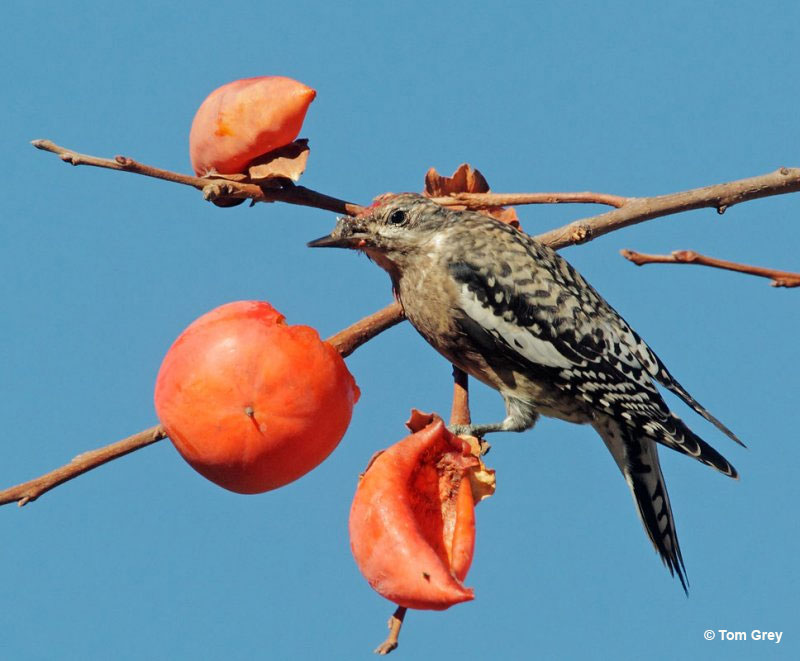
Scientific name: Sphyrapicus varius
Length: 8.5 inches
Wingspan: 16 inches
Yellow-bellied Sapsuckers are pretty, medium-sized woodpeckers with white shoulders. They have a black and white face, black chest, and uneven black and white barring on their backs.
This woodpecker species has pale yellow on its underparts, small black markings on its sides, and a red patch on its head.
Males also have a red throat bordered with black while females have a white throat. Juvenile Yellow-bellied Sapsuckers look like adults but are more dingy gray-brown, and lack red on their heads.
This migratory species likes to peck rows of small holes in deciduous trees. It drinks the sap that comes out as well as insects attracted to the sap.
Yellow-bellied Sapsuckers breed in northern and montane forests, but spend their winters in southern areas. They are common from October to April.
Key identifications:
- Yellow-bellied Sapsuckers are the only woodpeckers in most of their range with white shoulders.
- This species has a black chest and uneven barring on its sides.
- The Yellow-bellied Sapsucker has lots of uneven, mottled black and white barring on its back.
Red-cockaded Woodpecker
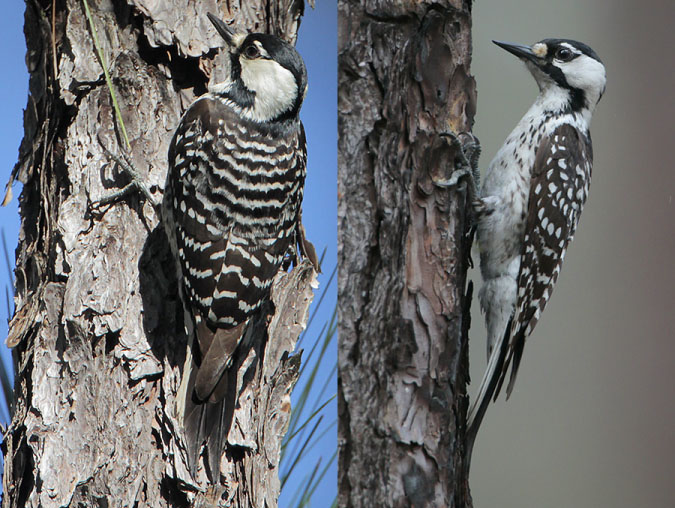
Scientific name: Dryobates borealis
Length: 8 inches
Wingspan: 14.2 inches
Red-cockaded Woodpeckers are smallish, black and white woodpeckers with black and white barring on their backs. They have a big white patch on each side of their head, a thick black moustache mark, and white underparts with small black markings on their sides.
Despite their name, it’s pretty hard to see the red on this bird! It takes a close, careful look to see the small red spot on the male’s head.
Red-cockaded Woodpeckers are locally common at scattered sites in the southeastern USA. It used to be much more common but declined as old growth forests were logged throughout its range. Thankfully their population is pretty stable in Alabama.
Key identifications:
- Each side of the Red-cockaded Woodpecker’s head is mostly white. Unlike several other black and white woodpeckers, it does not have a black line going back from the eye.
- This species has black and white barring on its back.
- Red-cockaded Woodpeckers have small black markings on their sides.
Frequently Asked Questions
What is the most common woodpecker in Alabama?
The most common woodpecker in Alabama is the Red-bellied Woodpecker. According to eBird data, this species is seen more than any other woodpecker in the state.
Are Red-headed Woodpeckers endangered in Alabama?
No, Red-headed Woodpeckers are not endangered in Alabama. They can be uncommon and local but are not endangered.
Are Pileated Woodpeckers rare in Alabama?
Pileated Woodpeckers are quite common in Alabama, especially in wooded parts of the state.
Conclusion
In Alabama, seven of the regular, common woodpeckers are doing well in their respective habitats. Downy and Hairy Woodpeckers are common throughout the state while Hairy Woodpeckers are more common in forested areas of northeastern Alabama.
Sadly, the Ivory-billed Woodpecker disappeared from the state’s cypress swamps in the early part of the 20th century. Red-cockaded Woodpeckers still occur but this near threatened species only lives in a few forests managed for the species.
As with other parts of its range, Red-cockaded Woodpeckers in Alabama need large areas of mature Longleaf Pines. They became rare after old growth forests were cut and replaced with Slash Pine.
More birds you can see in Alabama: Most common birds | Hawks | Owls | State bird

